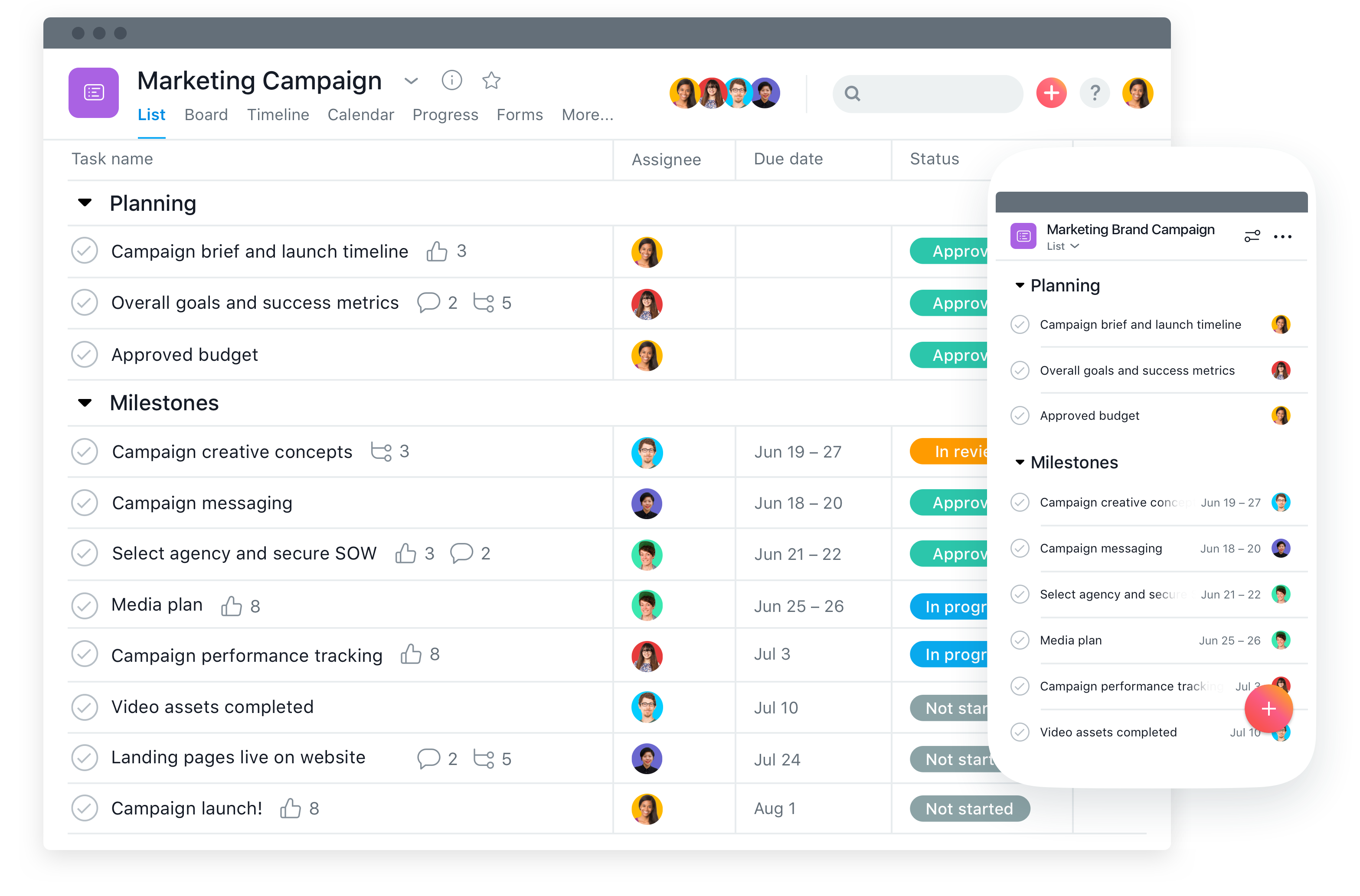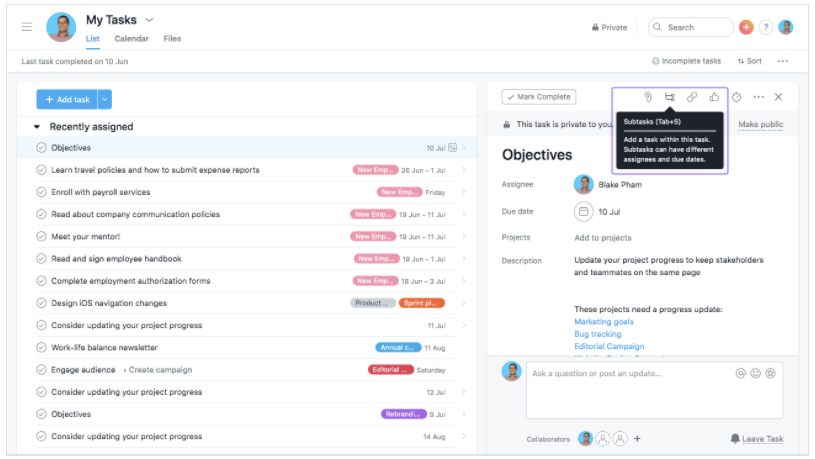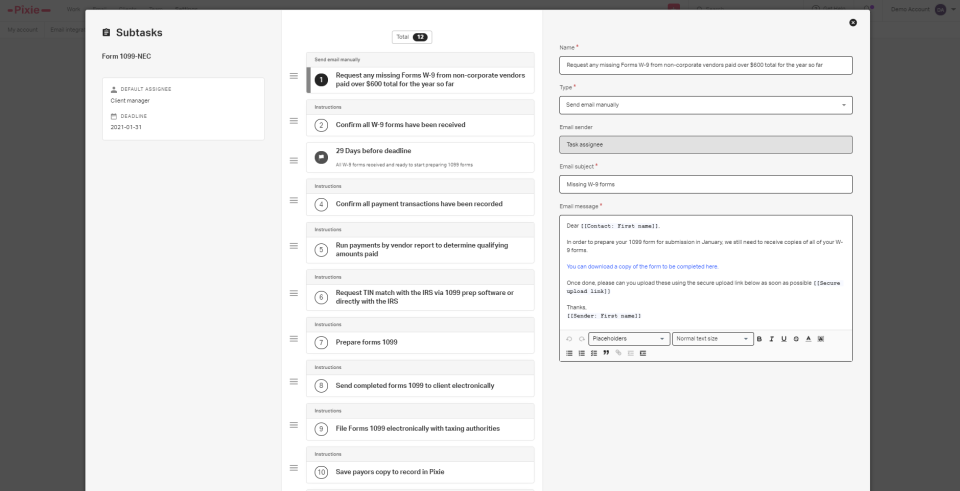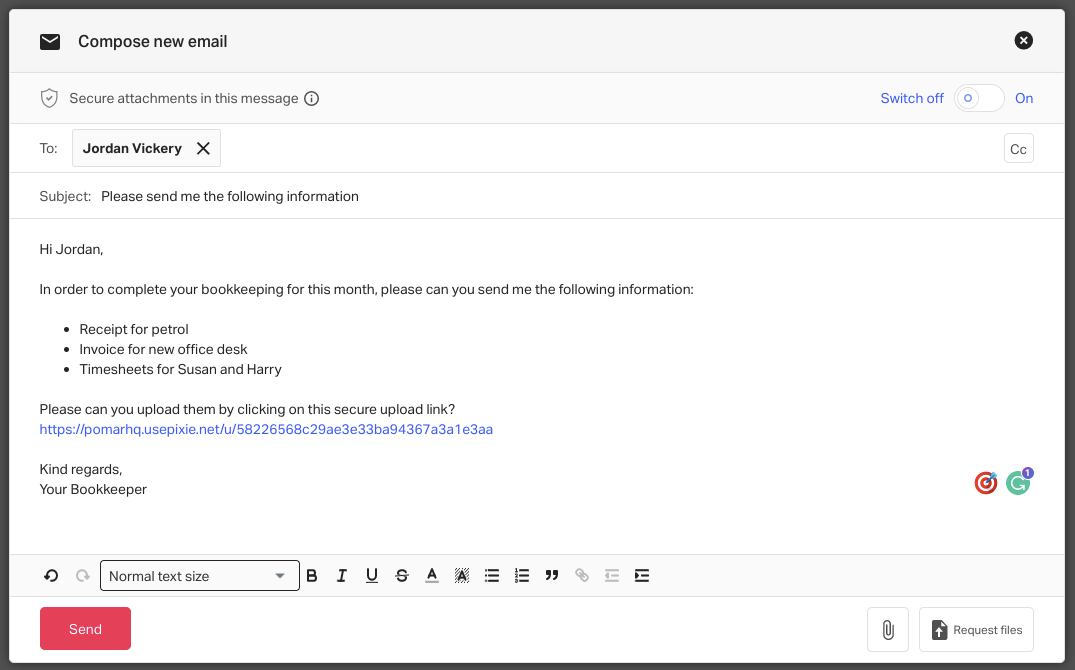Asana for bookkeepers and accountants: Is it the right fit for your firm? - Pixie
Want to know whether asana for bookkeepers and accountants is the right tool to use? We've weighed in to share our thoughts...

Asana is one of the biggest task & project management software tools out there.
This means it's no surprise that many bookkeepers and accountants choose to use Asana to manage their tasks, workflow, and team.
It has many great use cases for bookkeepers and accountants, some of which we'll look at below.
But is Asana really the best tool to use for managing your bookkeeping practice? What are some of its limitations?
In this guide, we'll look at the pros of Asana for bookkeepers and accountants, as well as some of the key reasons why Asana might not be the best solution for small growing firms.
What exactly is Asana and how does it work?
Asana is a task and project management tool designed to help you manage your team, your tasks, and your projects. It brings your team goals, plans, tasks, and files together into one place.
There are many additional features in Asana such as timelines, custom fields, forms, and automation rules, however, these are all part of the premium pricing plan and not the free plan that many accountants and bookkeepers opt for (more on that a little later on...)

So how do you use Asana?
In its simplest form, Asana is made up of the following...
Project
A project is a top-level structure where bookkeepers and accountants would normally have a project for each of their clients. A project is the place where all of the tasks, files, and deadlines for this client would live.
In the project section, you have options for:
- Project overview: Who is working on this project and what resources are available
- List: A list of all of the tasks in this project
- Board: A kanban style board of all of the tasks in this project
- Timeline: A visual project plan (Premium plans only)
- Calendar: A calendar view of deadlines
- Dashboard: Reports on your team's progress (Premium plans only)
- Messages: Messages with your team regarding this project
- Forms: For collecting information (Premium plans only)
- Files: All attachments for the project live here

Parent task
A parent task in Asana or bookkeepers would be the equivalent of a job. So for example, if you were working on a client's year-end bookkeeping, the project might be called 'Joe Bloggs Inc' and the parent task might be called 'Year-end bookkeeping'.
On parent tasks, you have options for:
- Changing the parent task assignee
- Changing the parent task deadline
- Adding some information in the description section
- Adding subtasks (see below)
- Applying tags
- Uploading files
- Leaving comments and/or asking your team questions
There are also some premium plan options available including adding milestones and creating task dependencies (i.e. this task depends on another)
Once tasks have been set up, you have the option to make them recurring. This is quite helpful for bookkeepers & accounting firms as a large part of your work is recurring on a weekly, monthly, quarterly or annual basis.

Sub tasks
Underneath your parent task, you would have a number of sub tasks. These are a series of mini-steps that your team needs to complete in order to complete that particular job. Here you would breakdown the workflow and create your processes.
On subtasks, you have all of the same options as parent tasks.

What are the benefits of asana for bookkeepers and accountants?
Now that you have a basic understanding of how Asana works, let's take a look at deeper dive into some of its pros and cons.
So what are some of the benefits of asana for bookkeepers and accounting firms?
Use Asana to manage your workflows
One of the great things about Asana is that you're able to use it to manage workflows for your accounting and bookkeeping clients.
Take your standard monthly bookkeeping process as an example. You can create a parent task (called monthly bookkeeping) and then under that build out the various subtasks involved. For each of those, you can set a deadline, choose an assignee, and you're left with a pretty nice workflow template that you can set to recur on a monthly basis.

That said, there are some limitations to using workflows in Asana, particularly around being able to set up email templates and automated email reminders for your client. But more on that later...
People like Alyssa Lang (the workflow queen) have a number of paid-for premium workflow templates available to help you set up asana and get your workflow up and running. You can check out the workflow queen website and find out more about their asana templates for bookkeepers and accountancy firms below.
Click here to see the workflow queen asana templates for bookkeepers.
Using Asana to manage deadlines and improve organization
As far as task and project management goes, Asana is great at helping to you to improve your organization and keep track of deadlines.
On your 'my tasks' screen, you'll have an overview of everything that's on your plate, and all of the tasks that you need to work on. From 'my tasks' you can click on the inbox tab where you'll be able to see any comments that have been left and get an update on tasks that have been completed.
You can also see here whether any tags have been applied to tasks to get an update on the progress of certain tasks, without having to dive into the detail.

Like before, there are a few limitations when it comes to managing deadlines and tasks in Asana, which we'll be covering shortly in the following section.
Use Asana to manage your team
Another good thing about Asana is that it makes it quite simple to manage your team members and what they're working on.
You can easily reassign tasks and subtasks so that they appear on their to-do lists, and not your own task list. You can also click on the names of your team members to see exactly what's on their plate.
Inside Asana on tasks, you can leave comments and ask your team members questions, which is good for keeping the communication between you and your team saved in one place.

Similar to workflows, there are however a few limitations of managing your team in Asana, for example not having visibility over the emails that they might send to your clients and potentially having to incur per-user costs if you opt for the premium plan. But we'll cover those in more detail shortly...
Why asana might not be the best solution for your bookkeeping practice
Whilst Asana has a number of benefits for bookkeepers and accountancy firms wanting to get a better grip on their workflow, tasks, and team, it's pretty much limited to only helping with those 3 things. Even then, there are a couple of reasons why it might not be the best solution for your bookkeeping practice.
So let's jump into some of the key limitations of using Asana to manage your accounting or bookkeeping practice...
1. Nowhere to store your bookkeeping client's information
One of the biggest drawbacks of using Asana is that it doesn't have anywhere to store your bookkeeping clients. Yes, you can set them up as a project, and keep all of their task information and deadlines there, but that's it.
So whilst it's great as a workflow and project management tool, your bookkeeping clients and their details will have to saved somewhere else. This is also one of the big limitations of ClickUp for bookkeepers.
Things like contact details, addresses, logins & passwords, email history, are all key pieces of information that you might need on hand when you're completing work.
By having the information in different places, there are a couple of challenges:
- It's not efficient to have to jump from one app, to another, and back to another in order to find information
- You need to maintain client records in multiple apps that each store different bits of information
- It's harder for you to have visibility over everything you need to manage your firm in one place
2. There is no email integration
Email is a fundamental communication channel used by accountants and bookkeepers, and yet it's missing from Asana.
If you need something from them, you email them. If they need something from you, they'll email you. All of these emails live in your inbox, which is completely disconnected from Asana where you're busy completing your work.
This can have a number of downsides:
- You don't have visibility over what emails have sent/received by a client when you're working on their tasks which means you have to jump from one app to another to find it
- You don't have the ability to create email templates for common responses and send these from Asana, or better yet, build them into your workflow templates as automated emails
- You have no visibility over the emails that your team have sent/received from clients, creating additional work to chase them up or ask them
Having your email inbox in the same place as your tasks and workflows can be a huge timesaver and have many benefits. We'll come on to those a little further down...
3. There isn't a secure document portal
Whilst Asana does have the option to upload files directly to tasks and projects, it doesn't give you the option to send files to your clients securely, or to request them from them as well.
This means that in order to request missing information as part of a task you're working on, you would have to leave Asana, and go to your inbox, or go and use a separate tool (which could incur an additional subscription cost) in order to send/request files securely.
This has some similar downsides to the lack of email integration, where instead of having the ability to manage this all in one place, you have to use a different application.
Imagine being able to do this from inside the same app where you manage your tasks? I'll show you how shortly...
How does Pixie compare to Asana for bookkeepers and accountants?
So by now, you should have a fair understanding of how Asana works, the benefits it can have for managing your accounting or bookkeeping practice, as well as some of the limitations it has as well.
So what are the alternatives?
One of the main alternatives to asana for bookkeepers and accountants is Pixie.
Pixie is a simple, flexible app where accountants and bookkeepers can manage their firm. It helps you to take control of your clients, deadlines, team, emails, and workflows in one place.
So how does it compare to Asana for bookkeepers and accounting firms?
Here are the 5 biggest differences between them both:
1. Pixie comes with a built-in CRM
Earlier on I mentioned that Asana didn't have anywhere to store your client's information.
Well in Pixie, when you create a new client, you set them up with their own record. And on their record, as well as being able to see their tasks & deadlines, you're also able to see:
- Contact information e.g. names, emails, and address
- Custom field information e.g. reference numbers, secure codes, log-in information
- Open tasks - what you're working on right now
- Client tasks - tasks and checklists you've assigned to your clients to complete
- Closed tasks - a history of everything you've done for them
- Scheduled tasks - all of the recurring services and tasks for that client
- Emails - a full email history of everything you AND your team have sent/received
- Files - file storage and files that you have been sent
- Notes - any additional information you want to store

Being able to keep all of this additional information (contact info, emails, notes etc) alongside your tasks save you from jumping between multiple apps when you need to find key information. Everything you need is in one place.
2. Pixie has an email integration with Gmail, Office365 and Outlook.com
Like we said earlier, email is a huge communication channel between you and your clients.
Which is one of the reasons why you're able to integrate and manage your email directly inside Pixie.
When you do this, you're able to do a couple of things:
- Manage your email inbox without having to leave Pixie and use another app
- Emails are auto-prioritized for you (so you don't need to go searching through your inbox to find the important client emails)
- Emails are auto-saved to client records (without you needing to create folders or set up fancy rules)
- You can convert emails into tasks in just 1 click (and the original email is attached as a reference)
- You can see what emails your team members have sent to clients, and what emails your clients have sent to your team
- You can set up email templates and automated email reminders (see the workflow section below)

Having your emails connected to Pixie is a huge timesaver, with many of our customers saying it has saved them hours a day. Literally.
3. Pixie has improved workflow functionality for accounting and bookkeeping firms
The workflows you can create in Asana, but in Pixie, you're able to take them one step further.
Here are 3 of the biggest workflow differences:
Checklists & videos
In your workflow templates, you're able to create checklists for your team to tick things off, as well as embed training videos which makes training and onboarding new team members a breeze.
Create email templates & send auto-emails
Need to request documents from your clients on the first of every month? No problem. Create the template once, put it at the start of your bookkeeping workflow and let Pixie send it out automatically for you. You can create a number of automated email templates to use for your different services.

Built for accountants & bookkeepers
Pixie was built specifically for accountants & bookkeepers. This means our workflows can be triggered by client dates e.g. the client's payroll date, or by other statutory deadlines. We also have a workflow template library of specific templates for services including bookkeeping, payroll, tax, and many others. When you start a free trial, your workspace comes pre-loaded with some workflow templates to help you get started!
4. You can send and request documents from your clients securely
As well as being able to store files on your client records, you can also send and request files securely directly inside Pixie.
You can insert encrypted file upload links into your emails (including your automated emails) which puts your information requests on autopilot and gives you peace of mind that all of your client's information is being handled securely.

You can also send files securely from Pixie by simply toggling the 'secure attachments' switch in any outbound emails.
5. No per-user pricing
Although Asana has their free plan, in order to really make the most of some of the additional tools in there like the automation, you would need to upgrade to their premium plan which is priced per user.
Here at Pixie, we don't believe in per-user pricing. We don't want you to pay more for growing your firm, and we don't want to discourage you from adding users just because it incurs additional costs.
That's why we have a flat pricing structure of just $59 per month, per firm. This includes unlimited users, unlimited clients, and unlimited features. So it doesn't matter whether you have 2 team members today, and 10 people in 6 months' time, the price will never change!
What's your verdict on Asana for bookkeepers and accountants?
Hopefully, after reading all of this way, you feel more informed to make a decision about asana for bookkeepers and accountants.
If you're just starting out and have a handful of clients and no team members, Asana is a great (and free) solution for you to use to manage your tasks and client's deadlines.
However, as you grow, and bring additional team members on board, you need to be able to keep track of everything in one place. This includes all of your client information, emails, and much more.

About the author
Celso Pinto
A Portuguese expat in London, Celso founded Pixie after learning first-hand about the challenges faced by small accountancy and bookkeeping practices. A product-focused leader with over 20 years experience in the software industry, at Pixie you'll frequently find him listening to customers and distilling their feedback into the product and go-to-market strategy.


